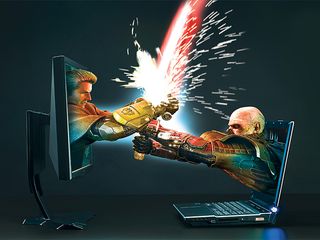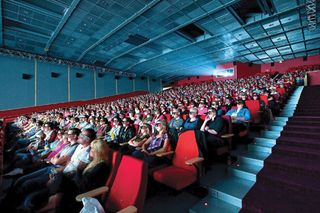Is 3D technology here to stay?
3D makes for eye-popping visuals, but will it stick around?

The third dimension is taking over your local cinema. It's assimilating your HDTV. It might even be popping out of your next smartphone.
And yes, it's creeping into PC gaming, too. It's the next big thing and it's 3D.
Of course, if we're talking PC gaming, then the term 3D is a little confusing. On PC Format, we've been soaking up the 3D gaming groove for nearly two decades, but that's 3D graphics painted onto a 2D screen.
When manufacturers hit the hype button regarding 3D today, what they are really referring to is stereoscopic 3D imaging. What this means is pictures popping out of the screen and poking you in the peepers, not the relentless quest for ever more photorealistic computer graphics courtesy of a games console or highend gaming rigs.
However, whatever you think about 3D (from now on, let's assume 3D means stereopscopic 3D), one thing it definitely isn't is new. 3D images have been knocking around for nearly 200 years and the technology involved in 3D movies dates back over 100 years. That's right – like so many things – the Victorians got there first.
It all started – probably - with a device known as the stereoscope, invented in 1838. It was the first gadget that keyed into the mechanics of human stereoscopic vision.
Humans, of course, have two eyes. The consequence is that each eye views the world from a slightly different angle and receives a slightly different image. The brain takes these offset images and composites them into a single mental picture with depth and perspective. You, therefore, see the world in glorious 3D.
Get daily insight, inspiration and deals in your inbox
Get the hottest deals available in your inbox plus news, reviews, opinion, analysis and more from the TechRadar team.
So, that's exactly what the stereoscope does – show each eye a still image from a slightly different angle and allow the brain to work its magic. Cue endless fairground fun and a roaring trade in early 3D pornography.
Like many technologies, good old porn helped with the early cash flow. Of course, the stereoscope had some very serious applications, too. It was used by the military to view aerial photographs, for instance.
Ongoing 3D

Fast forward to the 1890s and British inventor, William Friese-Greene patented a system for capturing and displaying motion stereoscopic pictures and 3D movies were born. Friese-Greene's technology turned out to be too unwieldy for commercial use, but the seeds were sown.
Several variations on the stereoscopic 3D movie riff were tried with the first known paying audience recorded in 1922. Further dabbling followed in the next few decades. Even the Nazis made a few propaganda flicks in 3D, but the golden age of 3D cinema was probably the 1950s.
A number of revivals have since rebooted the 3D revolution only to fade into obscurity. All of which brings us to the present day.
Indeed, after that potted history you might be tempted to disregard the latest 3D resurgence as another blip on the graph before an inevitable return to the historical flatline. This time, however, things are different.
This time, 3D is about much more than cheap cinema thrills. It's spreading into a wide range of platforms courtesy of many different technologies. That includes the promise of less unwieldy, more comfortable 3D viewing. Combine that with the interactivity of games and the result might just be the most immersive leisure experience yet. This time, 3D might be for real.
So, what are the different 3D technologies available today, how do they compare and where's it all heading?
In one sense, they're all the same. Generally, it's all about exposing each eye to a different image. Exactly how that is achieved, however, is where things get interesting.
The heyday of 3D cinema was based on so-called red-green analglyph technology. This involves a single picture containing a pair of merged, colour-shifted and spatially offset images. The viewer is required to wear colour-filtered lenses which effectively allow each eye to view a different offset image. This works pretty well in terms of creating the illusion of depth perception. It's a little more problematic when it comes to colours, however.
Inevitably, each eye is viewing the scene with radically different colours. While the brain is capable of compositing the image to generate the correct colours, it's a lot of work and perhaps contributes to the eye strain many viewers of 3D movies experience.
If coloured filters tend to be less than ideal, the most obvious alternative is polarised light. Again, the viewer is presented with a single picture frame within which two images are interleaved. The most common method is to use a pair of projectors, each with an orthogonally opposed light polarising filter. The viewer then wears glasses with similarly opposed polarising filters and Bob's your spear-poking, eye-popping uncle.
Technology and cars. Increasingly the twain shall meet. Which is handy, because Jeremy (Twitter) is addicted to both. Long-time tech journalist, former editor of iCar magazine and incumbent car guru for T3 magazine, Jeremy reckons in-car technology is about to go thermonuclear. No, not exploding cars. That would be silly. And dangerous. But rather an explosive period of unprecedented innovation. Enjoy the ride.
